Evaluating the Return on Automation’s Investment
Evaluating the Return on Automation’s Investment
One of the risks of being on the bleeding edge in an industry is, well, bleeding a lot of resources. “I like to push the envelope,” says Barry Dixon, owner of True House Inc. in Jacksonville, Florida. “I’ve purchased machinery in the past and then figured out how to make it work once it’s arrived in my plant. It hasn’t always gone exactly to plan.”
So what do you do if you want to be innovative but you don’t have the capital to bleed? Find someone else who has already gone through the process.
Based on his past experience, Barry says, “I want to shop ahead. Look at all the options that are potentially out there and working, and then figure out whether it could be incorporated into our business.” Naturally, when the opportunity arose to see some of the latest fabrication technology in action in Australia, Barry jumped at the chance.
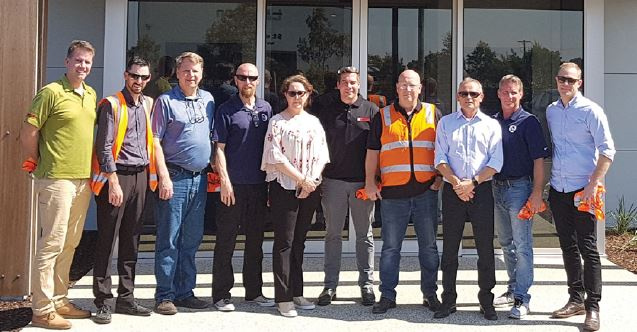
The group prior to their tour of Timber Truss (l to r): Steve Shrader, Travis McDonald, Jim Finkenhoefer, Brent Gibson, Penny O’Leary, Charlie Hutchings, Sam Rowe, Steve Collier, Barry Dixon and BJ Louws
He wasn’t alone. BJ Louws, president of Louws Truss in Ferndale, Washington, had been interested in going to Australia for a while. “We had a few Australian truss companies come and tour our plant a few years back and I was interested in doing some reciprocal visits to see what they were attempting to do,” says BJ. “I saw a couple of those guys in 2017 at BCMC in Omaha, and then again at the 2018 show in Milwaukee in the Hundegger booth.”
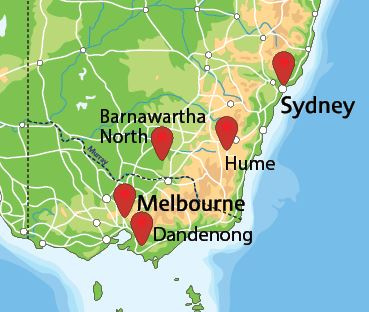
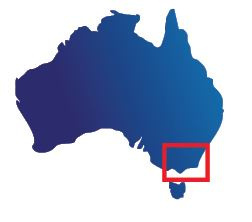
Steve Shrader, head of sales for Hundegger USA, knew there was interest in the U.S. to see how the Australians were approaching automated production, and he promoted an organized tour in his booth at BCMC 2018. “We brought over Penny and Steve from Timber Truss in Melbourne and they shared what they were able to do with a system that was only 75-80 percent optimized,” says Steve. “We had a lot of interest in the tour to see how it could be done.”
Joining Barry and BJ on Steve’s first tour was Jim Finkenhoefer, VP of operations for True House; Brent Gibson, production manager for True House’s Crescent City, Florida facility; and Chris Jordan and Jesse Jaramillo from BMC. They all arrived in Melbourne, Australia, at the height of the Australian Open tennis tournament. “Seeing a few of those matches and getting caught up in the atmosphere of that huge tournament was a great introduction to Australia and the perfect way to start the trip,” says Jim. “Then we spent the next four days touring state-of-the-art truss plants. It was a lot to take in, a bit like drinking from a fire hose.”
After arriving in Australia over the weekend, the group toured three plants in the Melbourne suburbs on Monday: MB Pre-Fab Framing in Breakwater, Calco Timbers in Geelong South, and Timber Truss in Corio.
“Timber Truss was like Katerra on steroids,” says Barry. That’s saying something given Katerra has made front page news the past few years pumping millions of investment dollars into their production facility in Phoenix to fine tune an efficient production process. “Timber Truss has also spent millions automating their plant with new equipment. But given their labor issues, the return on investment was likely only in the five to seven year range. It would take a lot longer to get that return at a plant in the U.S.”
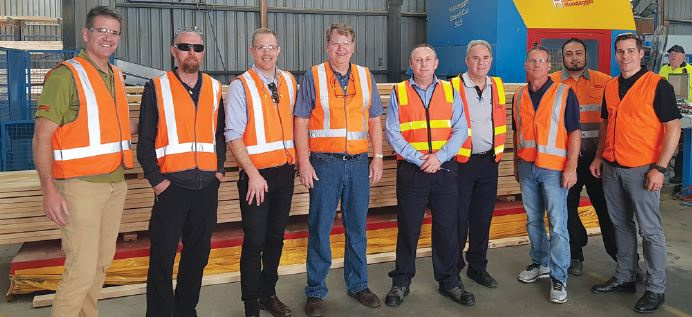
The group during their tour of MB Pre-Fab Framing Pty Ltd facility (l to r): Steve Shrader, Brent Gibson, BJ Louws, Jim Finkenhoefer, Doug Maxwell, Darren Benn, Barry Dixon, and Charlie Hutchings
Everyone on the tour of Timber Truss commented on the level of automation they saw. “That was where we saw what is possible in the future,” says BJ. “They don’t have as much diversity in their truss layouts as we do in the U.S., so that makes some automation easier for them. That said, at Timber Truss they could build anything they wanted.”
BJ observed that the Australian building code favored hydraulic over roller plate pressing and that tended to push more of the CMs toward using hydraulic presses. “There also appeared to be lower lumber variability. They typically used only 2x4 and 2x6 equivalent sizes because they’re not doing pole barns or attic trusses,” says BJ. Combine that with BJ’s observation that Australian CMs typically use only one or two grades of machine stress rated MEL lumber, and automation makes even more sense to implement.
On Tuesday, the group traveled to Timber Building Systems in Dandenong, and on Wednesday they toured a cross-laminated timber (CLT) production facility in Barnawartha. “Not only do they produce the CLT there, they also cut it and deliver finished product to the jobsite for installation,” says Steve.
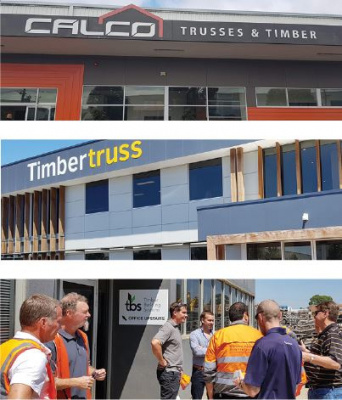
On Wednesday, the group concluded their tours by visiting Universal Trusses. “They were staffed almost entirely by former Toyota automotive production employees,” says Jim. “They had been building apartment units for over a year, and were still changing things up, trying to perfect their process.”
Most of the group finished the week in Sydney, celebrating Australia’s independence day in style before flying back to the States. BJ, on the other hand, joined another tour group, this time with MiTek, and retraced some of his steps. “I actually ended up walking through Timber Truss twice on that trip,” he says. “The second time around I spent more time sitting down with the CMs and talking about their markets and business challenges.”
One of the reasons why Australia has been quick to seek out the latest automation equipment is their high cost of labor. “They don’t have the immigrant labor options we have here in the U.S., and their minimum wage in the industry is close to $20 an hour,” says Barry. “Hiring more people to increase production isn’t a great option, so they have a strong motivation to automate.”
“We have labor issues in the Pacific Northwest,” says BJ. “Regulations are very stringent here, not to mention requirements for health coverage and time off. I wouldn’t be surprised if our minimum wage reaches $15 an hour in a few years.” The similarity between his labor woes and that of the Australians was one of the reasons why he was eager to see how they were approaching automation and calculating their return on investment (ROI).
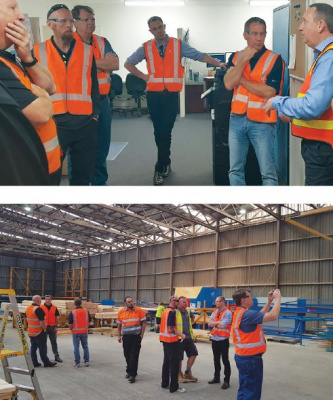
What the group saw on the tour over those four days was impressive. “I walked into my first truss plant in the early 1970s. What I saw at a few of those plants in Australia was straight out of the ‘Jetsons’ cartoon,” says Jim. “We watched four guys running eight saw lines simultaneously. It showed us what automation can truly achieve.” The glimpse into advanced component manufacturing in Australia gave everyone insight into what would need to be different in order for automation to be successful in the U.S.
One observation everyone in the group kept revisiting was the quality of the labor on the production lines. “It was astounding,” says Jim. “They may need less labor, but they had to hire a much higher caliber individual to run all of those automated machines.” Both Jim and Barry were quick to point out that it didn’t have anything to do with intelligence, it had to do with education and training. “When you automate, you also commit to a lot of technical training for individuals and group training so they work smoothly together,” says Jim.
In the evenings, they debriefed as a group. “Barry and I look at similar metrics,” says BJ. “It was so huge to be able to talk and compare notes in the evening and get meaningful feedback on what we saw.” BJ pointed out that’s one of the reasons why BCMC is such a big deal, “I usually know what’s going to be on the show floor before I go to the show but the value is in having conversations with other CMs about how the new equipment can be incorporated into an existing system.”
Beyond getting BJ’s input, Barry brought a team along because he wanted to foster an internal dialogue on how to implement change. “I wanted my team to see the technology in action and talk about it without the pressure of having to immediately make it work,” says Barry. He felt the nightly conversations and discussions on the bus built camaraderie as they tried to figure out how they could make a certain automated approach work in their current facilities.
In addition, there was a specific piece of equipment he was contemplating and one of the only places to see it in action was in Australia. “Nobody in the U.S. had one up and running, so we had to go somewhere else. I saw it in action and now I need to go to Europe to gather more data,” says Barry.
Being away from the office for a week and traveling to Australia is a significant investment in itself. It also doesn’t promise 100 percent satisfaction. “I was very disappointed,” says Barry. “It took six days before I saw my first kangaroo.”
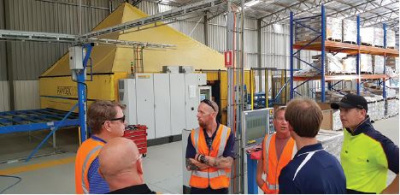
In all seriousness (and personal goals aside), everyone felt the trip was a huge success for their respective businesses. “The biggest value was in the relationships I nurtured and the connections I made,” says BJ. “It also opened my eyes that there are a lot of ways to solve a problem beyond just automation.” BJ stressed that one of his primary conclusions from looking at all the automation was that the latest and greatest technology isn’t always the best answer. “The tours gave me insight into how I could tweak a few things we are already doing and get close to what some of those high-end facilities were doing.”
What was also clear to Barry and BJ was that turning toward automation requires dedicated buy-in from suppliers. “Advanced equipment needs to be fully integrated with everything else you have and that necessitates your suppliers be willing and able to work with you to make that happen,” says BJ. “It was very evident their suppliers invested a lot to help make them successful.”
“If you’re going to make a huge investment in automated equipment, take any opportunity to see it in action before you buy,” says Barry. “Make sure your key people are comfortable with how you can make it work before it shows up. Trips like this are key to making that happen.”

